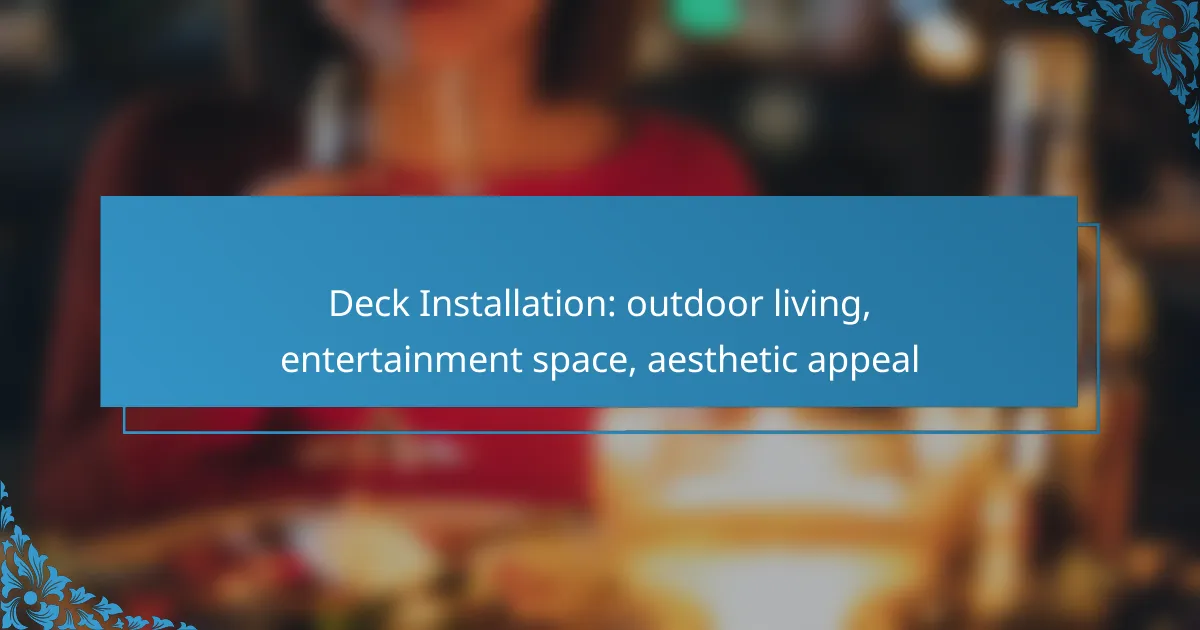Deck installation transforms outdoor spaces into inviting areas for relaxation and entertainment, significantly enhancing both aesthetic appeal and property value. By selecting the right materials and following a structured installation process, homeowners can create a durable and functional environment tailored to their needs.

What are the benefits of deck installation in Toronto?
Deck installation in Toronto offers numerous advantages, enhancing outdoor living and increasing property value. Homeowners can create a functional and attractive space for relaxation and entertainment, making it a worthwhile investment.
Enhanced outdoor living space
Installing a deck significantly expands your outdoor living area, providing a dedicated space for various activities. Whether it’s hosting barbecues, enjoying morning coffee, or simply relaxing in the sun, a deck transforms your backyard into a versatile extension of your home.
Consider the layout and size of your deck to maximize its utility. A well-designed deck can accommodate furniture, plants, and even outdoor kitchens, enhancing your overall outdoor experience.
Increased property value
A well-constructed deck can boost your property’s market value, making it more appealing to potential buyers. In Toronto, outdoor spaces are highly sought after, and a deck can set your home apart in a competitive real estate market.
Investing in quality materials and professional installation can yield a return on investment of 70% or more when selling your home. This makes deck installation not just an aesthetic choice, but a financially sound decision as well.
Improved aesthetic appeal
Decks enhance the visual appeal of your home, providing a stylish focal point in your yard. With various materials and designs available, you can choose a look that complements your home’s architecture and landscaping.
Consider using materials like composite decking or natural wood to achieve the desired aesthetic. Adding features like railings, lighting, and built-in seating can further elevate the overall design.
Ideal for entertainment
Decks are perfect for entertaining guests, offering an open-air environment for gatherings. They provide ample space for outdoor furniture, grills, and dining setups, making them ideal for summer parties and family get-togethers.
Incorporating features like a pergola or outdoor lighting can enhance the ambiance, allowing you to enjoy your deck well into the evening. Planning for seating and flow can help accommodate larger groups comfortably.
Durability and low maintenance
Modern decking materials are designed to withstand the elements, ensuring durability and longevity. Many options require minimal maintenance, allowing you to enjoy your outdoor space without the hassle of frequent upkeep.
Composite materials, for example, resist fading, staining, and warping, making them a practical choice for Toronto’s variable climate. Regular cleaning and occasional inspections can help maintain the deck’s appearance and functionality over time.

How to choose the right materials for deck installation?
Choosing the right materials for deck installation involves considering durability, maintenance, cost, and aesthetic appeal. The best options will depend on your specific needs, local climate, and budget.
Wood options: cedar and pressure-treated pine
Cedar and pressure-treated pine are popular wood choices for decking. Cedar is naturally resistant to decay and insects, making it a long-lasting option, while pressure-treated pine is more affordable and widely available.
When selecting wood, consider the climate in your area. Cedar performs well in various weather conditions but may require regular sealing to maintain its color. Pressure-treated pine, on the other hand, typically has a lifespan of around 15 to 20 years with proper care.
Composite decking benefits
Composite decking is made from a blend of wood fibers and plastic, offering a low-maintenance alternative to traditional wood. It resists fading, staining, and mold, making it ideal for outdoor spaces that see heavy use.
While composite materials can be more expensive upfront compared to wood, their durability and minimal upkeep can save money over time. Many brands offer warranties of 20 years or more, providing peace of mind for homeowners.
Aluminum decking advantages
Aluminum decking is another durable option that is resistant to rust, corrosion, and insect damage. It is lightweight and can withstand extreme weather conditions, making it suitable for various climates.
This type of decking often comes with a higher initial cost but offers longevity and minimal maintenance. Additionally, aluminum decking is available in various colors and finishes, allowing for customization to match your outdoor aesthetic.

What is the typical deck installation process?
The typical deck installation process involves several key steps, including site assessment, obtaining permits, constructing the foundation and framing, and finally installing the deck surface. Each stage is crucial for ensuring a durable and aesthetically pleasing outdoor living space.
Site assessment and design
The site assessment and design phase is essential for determining the best location and layout for your deck. Factors such as sunlight exposure, drainage, and existing landscaping should be considered to optimize functionality and aesthetics.
During this phase, homeowners can work with a designer or contractor to create a plan that meets their needs while adhering to local building codes. Sketching out the dimensions and materials can help visualize the final product.
Obtaining necessary permits
Before construction begins, it’s important to obtain the necessary permits from local authorities. This step ensures compliance with zoning laws and building codes, which can vary significantly by region.
Check with your local building department to understand the specific requirements for deck installation in your area. Failing to secure permits can lead to fines or the need to dismantle the deck later.
Foundation and framing construction
The foundation and framing construction phase involves laying a solid base for the deck. This typically includes footings, posts, and beams that support the deck structure. Proper spacing and depth of footings are crucial for stability.
Using pressure-treated lumber or composite materials for framing can enhance durability and resistance to weather elements. Ensure that the framing is level and square before proceeding to the next step.
Deck surface installation
The final stage is the installation of the deck surface, which can be made from wood, composite, or other materials. Each option has its benefits, such as cost, maintenance, and appearance.
When installing the surface, leave appropriate gaps between boards for drainage and expansion. Regularly check for any loose boards or fasteners after installation to maintain safety and aesthetics over time.

How much does deck installation cost in Ontario?
The cost of deck installation in Ontario typically ranges from CAD 20 to CAD 50 per square foot, depending on materials and design complexity. Homeowners should consider both initial expenses and long-term maintenance when budgeting for their outdoor living space.
Average pricing per square foot
In Ontario, the average cost for deck installation can vary significantly based on the type of materials used. For pressure-treated wood, prices usually fall between CAD 20 to CAD 30 per square foot, while higher-end options like cedar can range from CAD 30 to CAD 45. Composite decking, known for its durability, typically costs between CAD 30 and CAD 50 per square foot.
Factors influencing cost
Seasonality can affect pricing as well. Installing a deck during peak construction months may lead to higher labor costs, while off-season installations might offer savings. Always obtain multiple quotes to ensure competitive pricing.
Cost comparison: wood vs. composite
When comparing wood and composite materials for deck installation, consider both upfront costs and long-term value. Wood decks are generally less expensive initially but require regular maintenance, such as staining and sealing, which can add to long-term costs. In contrast, composite decking has a higher initial price but is often more durable and requires less maintenance over time.
For example, while a wood deck may cost CAD 25 per square foot to install, the ongoing maintenance could add CAD 1,000 or more over several years. Conversely, a composite deck might start at CAD 35 per square foot but could save homeowners money in maintenance costs, making it a worthwhile investment in the long run.
